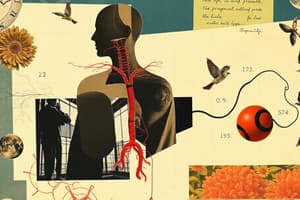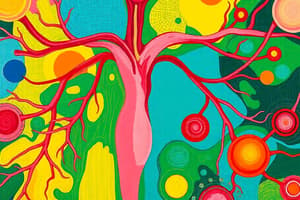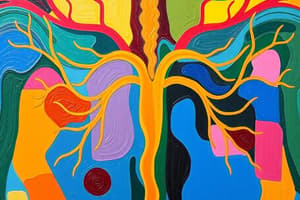Podcast
Questions and Answers
Where are the hormones secreted by the endocrine system carried to?
Where are the hormones secreted by the endocrine system carried to?
Blood
What are the three main types of hormones based on their chemical structure?
What are the three main types of hormones based on their chemical structure?
- Amino acid hormones (correct)
- Fatty acid hormones
- Steroid hormones (correct)
- Protein (polypeptide) hormones (correct)
Hormones can only affect target organs that are directly connected to the gland that secreted them.
Hormones can only affect target organs that are directly connected to the gland that secreted them.
False (B)
What is the name of the connection between the hypothalamus and the anterior pituitary?
What is the name of the connection between the hypothalamus and the anterior pituitary?
What is the name of the mechanism by which hormones exert their action?
What is the name of the mechanism by which hormones exert their action?
What are the two main types of hormone action based on their chemical nature?
What are the two main types of hormone action based on their chemical nature?
Steroid hormones can directly cross the cell membrane and interact with their receptors within the nucleus.
Steroid hormones can directly cross the cell membrane and interact with their receptors within the nucleus.
What is the name of the mechanism by which the endocrine system maintains a constant hormone level in the blood?
What is the name of the mechanism by which the endocrine system maintains a constant hormone level in the blood?
Negative feedback mechanisms increase the production of a hormone when its level is high in the blood.
Negative feedback mechanisms increase the production of a hormone when its level is high in the blood.
What is the main function of the thyroid hormone?
What is the main function of the thyroid hormone?
What is the name of the hormone that stimulates the release of thyroid hormone?
What is the name of the hormone that stimulates the release of thyroid hormone?
Flashcards
What does the endocrine system consist of?
What does the endocrine system consist of?
The endocrine system is composed of glands without ducts, which secrete hormones directly into the bloodstream via blood sinusoids or fenestrated capillaries. These glands include the pituitary, adrenal, thyroid, parathyroid, and pineal.
What are hormones?
What are hormones?
Hormones are chemical substances secreted by specific cells that affect distant organs. They regulate biochemical reactions and bodily processes like growth, maturation, regeneration, and reproduction.
What are the main types of hormones based on their chemical structure?
What are the main types of hormones based on their chemical structure?
Hormones are classified into three main types: protein (polypeptide) hormones, steroid hormones, and amino acid hormones.
What is the role of the anterior pituitary gland?
What is the role of the anterior pituitary gland?
Signup and view all the flashcards
What is the role of the posterior pituitary gland?
What is the role of the posterior pituitary gland?
Signup and view all the flashcards
How do hormones exert their effects?
How do hormones exert their effects?
Signup and view all the flashcards
What is up-regulation and down-regulation in hormone receptors?
What is up-regulation and down-regulation in hormone receptors?
Signup and view all the flashcards
What is the primary function of the Hypothalamo-Hypophyseal portal circulation?
What is the primary function of the Hypothalamo-Hypophyseal portal circulation?
Signup and view all the flashcards
What is the Hypothalamo-Hypophyseal tract?
What is the Hypothalamo-Hypophyseal tract?
Signup and view all the flashcards
What are the steps involved in the non-genomic action of protein hormones?
What are the steps involved in the non-genomic action of protein hormones?
Signup and view all the flashcards
What is the role of adenyl cyclase in protein hormone action?
What is the role of adenyl cyclase in protein hormone action?
Signup and view all the flashcards
What is the role of inositol triphosphate (IP3) and diacylglycerol (DAG) in protein hormone action?
What is the role of inositol triphosphate (IP3) and diacylglycerol (DAG) in protein hormone action?
Signup and view all the flashcards
What are the main characteristics of the genomic action of steroid hormones?
What are the main characteristics of the genomic action of steroid hormones?
Signup and view all the flashcards
How do thyroid hormones exert their effects?
How do thyroid hormones exert their effects?
Signup and view all the flashcards
What is negative feedback in hormone regulation?
What is negative feedback in hormone regulation?
Signup and view all the flashcards
What are the different types of negative feedback loops?
What are the different types of negative feedback loops?
Signup and view all the flashcards
What is positive feedback in hormone regulation?
What is positive feedback in hormone regulation?
Signup and view all the flashcards
What is the origin of the pituitary gland?
What is the origin of the pituitary gland?
Signup and view all the flashcards
What are the main parts of the pituitary gland?
What are the main parts of the pituitary gland?
Signup and view all the flashcards
What is the function of the parathyroid gland?
What is the function of the parathyroid gland?
Signup and view all the flashcards
What are the two main cell types in the parathyroid gland?
What are the two main cell types in the parathyroid gland?
Signup and view all the flashcards
How does the thyroid gland develop?
How does the thyroid gland develop?
Signup and view all the flashcards
What is the role of the thyroid gland?
What is the role of the thyroid gland?
Signup and view all the flashcards
What are the steps involved in thyroid hormone synthesis?
What are the steps involved in thyroid hormone synthesis?
Signup and view all the flashcards
What are some of the major effects of thyroid hormones on metabolism?
What are some of the major effects of thyroid hormones on metabolism?
Signup and view all the flashcards
What are the major effects of thyroid hormones on the body systems?
What are the major effects of thyroid hormones on the body systems?
Signup and view all the flashcards
What is hypothyroidism?
What is hypothyroidism?
Signup and view all the flashcards
What are the primary causes of hypothyroidism?
What are the primary causes of hypothyroidism?
Signup and view all the flashcards
What are the characteristics of Myxoedema (hypothyroidism in adults)?
What are the characteristics of Myxoedema (hypothyroidism in adults)?
Signup and view all the flashcards
What are the characteristics of cretinism (hypothyroidism in infants)?
What are the characteristics of cretinism (hypothyroidism in infants)?
Signup and view all the flashcards
What is hyperthyroidism (thyrotoxicosis)?
What is hyperthyroidism (thyrotoxicosis)?
Signup and view all the flashcards
What are some of the key characteristics of hyperthyroidism?
What are some of the key characteristics of hyperthyroidism?
Signup and view all the flashcards
What is a goiter?
What is a goiter?
Signup and view all the flashcards
Name three types of goiters
Name three types of goiters
Signup and view all the flashcards
What are goitergenic substances and how do they affect thyroid function?
What are goitergenic substances and how do they affect thyroid function?
Signup and view all the flashcards
What is the role of the pineal gland?
What is the role of the pineal gland?
Signup and view all the flashcards
Study Notes
Endocrine System
- Contains glands that release hormones directly into the bloodstream, without ducts.
- Includes glands like the pituitary, suprarenal, thyroid, parathyroid, and pineal body, as well as cell clusters in other organs like ovaries and testes.
- Hormones are chemical substances secreted by specific cells, affecting distant organs and regulating biochemical processes like growth, maturation, regeneration and reproduction.
Hormone Chemical Structure
- Protein/Polypeptide: Secreted by the anterior pituitary (FSH, TSH, ACTH, LH, PRL, GH), posterior pituitary (ADH, oxytocin), pancreas (insulin, glucagon), parathyroid, and hypothalamic hormones.
- Steroid: Secreted by adrenal cortex (cortisol, aldosterone), ovaries (estrogen, progesterone), and testes (testosterone).
- Amino acid-derived: Secreted by thyroid (thyroxine, adrenaline, noradrenaline).
Interrelation Endocrine & Nervous Systems
- Hypothalamo-Hypophyseal Portal Circulation: Blood system connecting the hypothalamus to the anterior pituitary, carrying releasing and inhibiting hormones.
- Hypothalamo-Hypophyseal Tract: Nervous connection between the hypothalamus and posterior pituitary, carrying ADH and oxytocin.
Mechanisms of Hormone Action
- Hormones bind to receptors (proteins) on target cells, initiating a specific response.
- Receptors can be located on the cell surface (protein hormones) or inside the cell (steroid hormones).
- The hormone-receptor binding initiates intracellular signaling pathways (second messengers), leading to a cellular response.
Feed Back Control of Hormones
- Negative Feedback: The secretion of a hormone by a gland is regulated by the level of hormone in the blood. Increasing levels of a hormone trigger a decrease in its secretion, maintained at a constant level.
- Short-Loop Feedback: A hormone inhibits the release of its own releasing hormone from the hypothalamus (a short inhibitory feedback loop).
- Long-Loop Feedback: A hormone inhibits the release of its releasing hormone from the hypothalamus and pituitary gland (a longer feedback loop).
- Positive Feedback: One hormone stimulates the secretion of another hormone. For example, an increase in estrogen may stimulate an increase in luteinizing hormone. This is a positive feedback cycle that amplifies the hormone response.
Embryological Preview of Pituitary Gland
- The pituitary gland develops from two sources: Rathke's pouch and the infundibulum (at the roof and floor of the developing forebrain/mouth).
- Rathke's pouch grows towards the diencephalon.
- An extension from the floor of the diencephalon meets the pouch.
- The infundibulum, or pituitary stalk, remains connecting the hypothalamus and the pituitary, containing the nerve fibers connecting both.
Histology of Pituitary Gland
- Pars Distalis: Composed of chromophobes (pale cytoplasm cells) and chromophils (granular cytoplasm cells). Chromophils are divided into acidophils (somatotrophs and mammotrophs) and basophils (thyrotrophs, corticotrophs, and gonadotrophs).
- Pars Tuberalis: Basophilic cells, with unknown function in some species, secreting gonadotropins (FSH & LH).
- Pars Intermedia: Basophilic cells, rudimentary in humans but in some species, secrete melanocyte-stimulating hormone.
Pituitary Gland Development
- Details on how the anterior and posterior lobes of the pituitary develop from Rathke's pouch and the infundibulum.
Anatomy of the Pituitary Gland
- Provides detailed information on the location, parts, and structures of the pituitary gland.
Histology of Thyroid Gland
- Stroma: Composed of a capsule and connective tissue.
- Parenchyma: Composed of thyroid follicles (basic functional units) that contain colloid (iodinated glycoprotein) and follicular cells (that secrete hormones T3 and T4), and parafollicular cells (that secrete calcitonin).
Hormones Secreted by the Anterior Pituitary
- Thyroid-stimulating hormone (TSH): Stimulates thyroid hormone release.
- Adrenocorticotropic hormone (ACTH): Stimulates adrenal cortex function.
- Follicle-stimulating hormone (FSH): Stimulates follicle development.
- Luteinizing hormone (LH): Stimulates ovulation and progesterone secretion (females) or testosterone secretion (males).
- Growth hormone (GH): Promotes growth and affects metabolism.
- Prolactin (PRL): Promotes lactation.
Hormones Secreted by Posterior Pituitary
- Antidiuretic hormone (ADH): Influences water reabsorption in the kidneys.
- Oxytocin: Stimulates uterine contractions and milk ejection.
Diabetes Insipidus
- It is a disorder caused by a deficiency of ADH, resulting in excessive urination.
Hormones Secreted by the Parathyroid Gland
- Parathyroid hormone (PTH): Increases blood calcium levels (in addition to other important functions).
Calcium Homeostasis
- A crucial process in the body that maintains calcium levels, impacting nerve and muscle function and bone health.
- Maintained by PTH (parathyroid hormone), vitamin D, and calcitonin.
- The amount in the body is controlled through various mechanisms—kidneys, bones, and intestines.
Action of Vitamin D
- Activation: Starts in the skin from 7-dehydrocholesterol then goes to the liver and then kidneys are to become 1,25-dihydroxyvitamin D3 (active form)
- Action: Increases the absorption of calcium in the intestines. It works on the kidney to increase the reabsorption of calcium.
- Deficiencies/excess: Results in various physiological disorders, such as osteomalacia, rickets in children, and hypercalcaemia in adults.
Mechanism of Activation of Vitamin D
Pituitary Dwarfism / Cretinism (Infantile Hypothyroidism)
Hyperthyroidism/Cushing's syndrome
Anatomy of the Suprarenal Glands
- Embryological preview: Cortical development from mesodermal cells, medullary development from neural crest cells.
- Structure: Gland has cortex and medulla.
- Blood supply: Details on the different arteries supplying the gland
- Provide a description of location of each layer
Histology Suprarenal Glands
- Stroma: The capsule and framework of connective tissue.
- Parenchyma:
- Zona glomerulosa: Cells arranged in clusters.
- Zona fasciculata: Cells in long columns
- Zona reticularis: Interconnecting network, and
- Medulla: Chromaffin cells
Chromaffin Cells
- Modified sympathetic nerve cells.
- Secrete catecholamines (epinephrine, norepinephrine).
Adrenal Cortex Hormones (Cortisol, Aldosterone)
- Cortisol: Regulates carbohydrate, fat, and protein metabolism.
- Aldosterone: Regulates sodium and potassium balance.
Anatomy of Pineal Body
- Structure: Composed of pinealocytes and supportive cells.
- Location: Located deep within the brain.
- Histology: Shows typical neuroendocrine cells.
Thyroid Development
- Details of the embryological development of the thyroid gland
- Shows structure of various areas of the gland
Anatomy of the Parathyroid Glands
- Embryological preview: Development from the pharyngeal pouch.
- Structure: Glands embedded in the thyroid.
- Histology: Features of the chief and oxyphil cells.
Hormones of the Thyroid Gland (Thyroxine, Calcitonin)
- Thyroxine (T4): Increases metabolic rate and is vital for growth.
- Calcitonin: Decreases blood calcium levels.
Anatomy Male Genital Organs
Anatomy Female Genital Organs
Histology of Male Genital Organs
Histology of Female Genital Organs
Studying That Suits You
Use AI to generate personalized quizzes and flashcards to suit your learning preferences.




